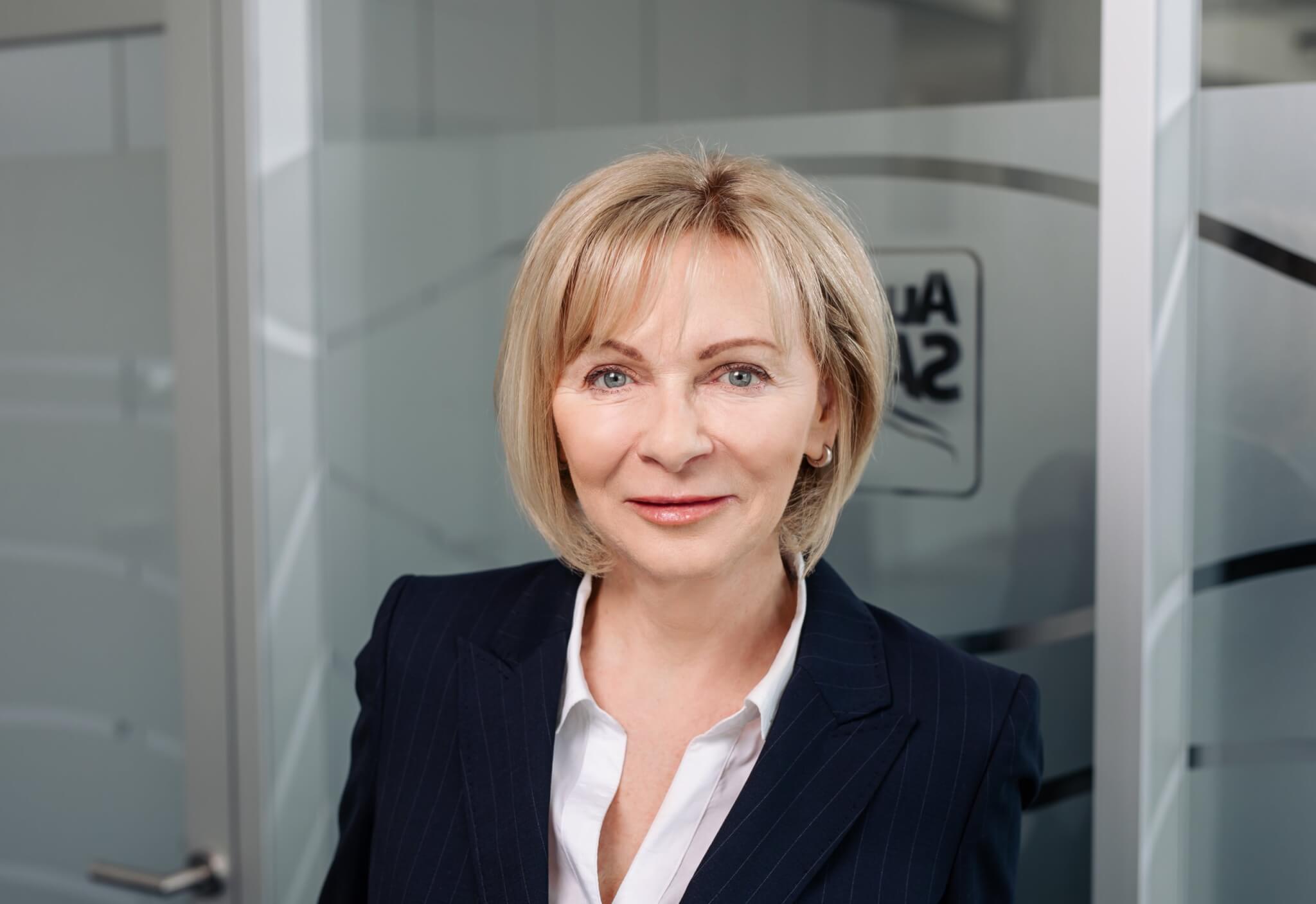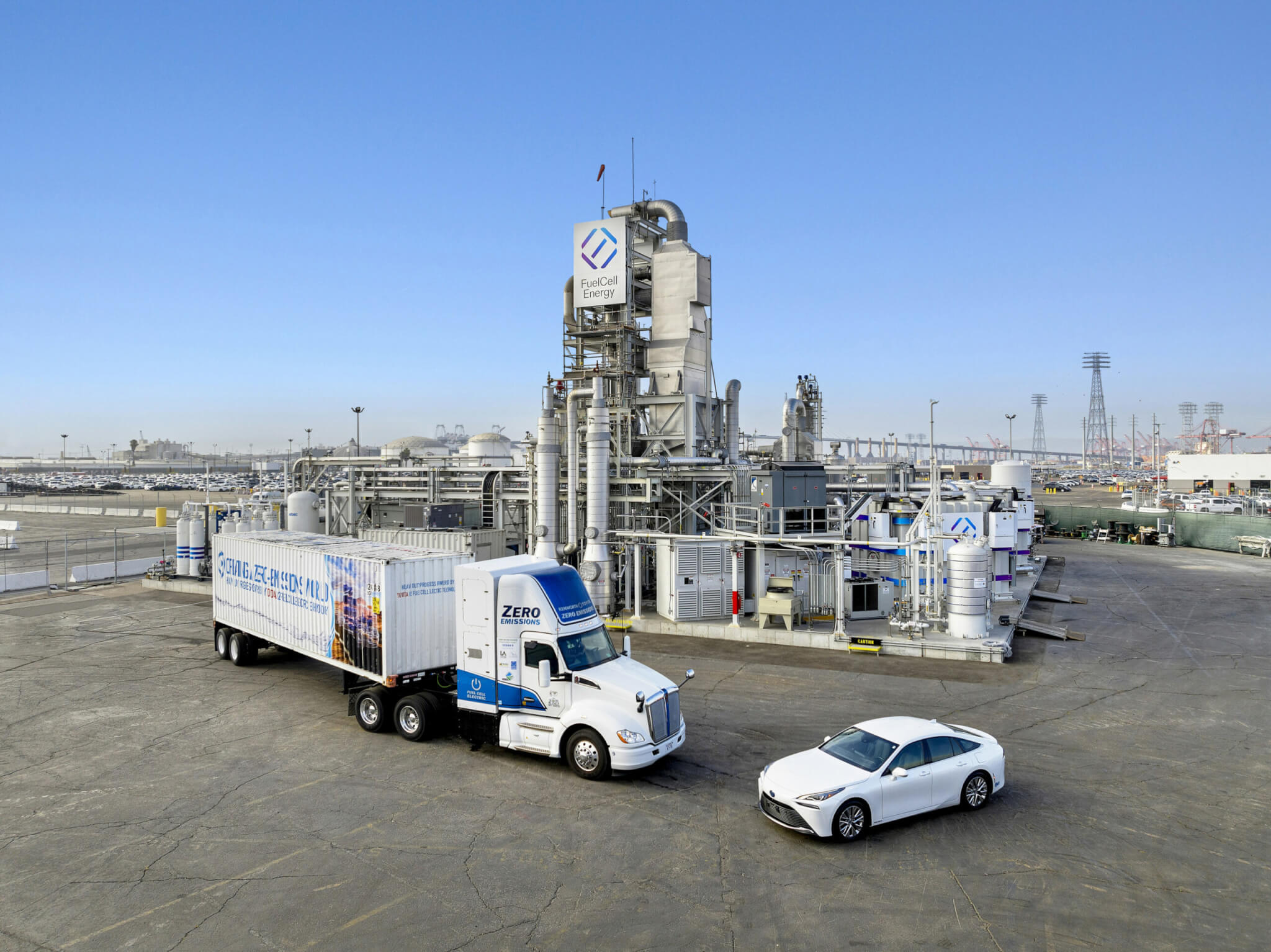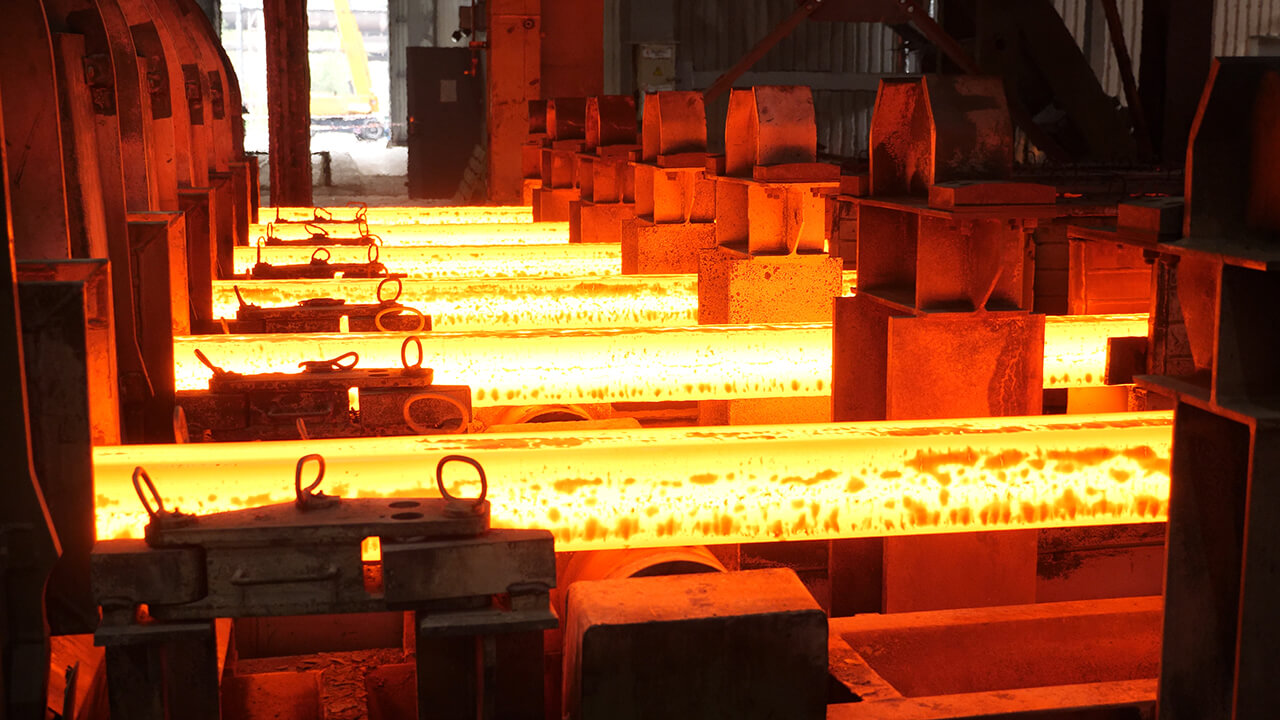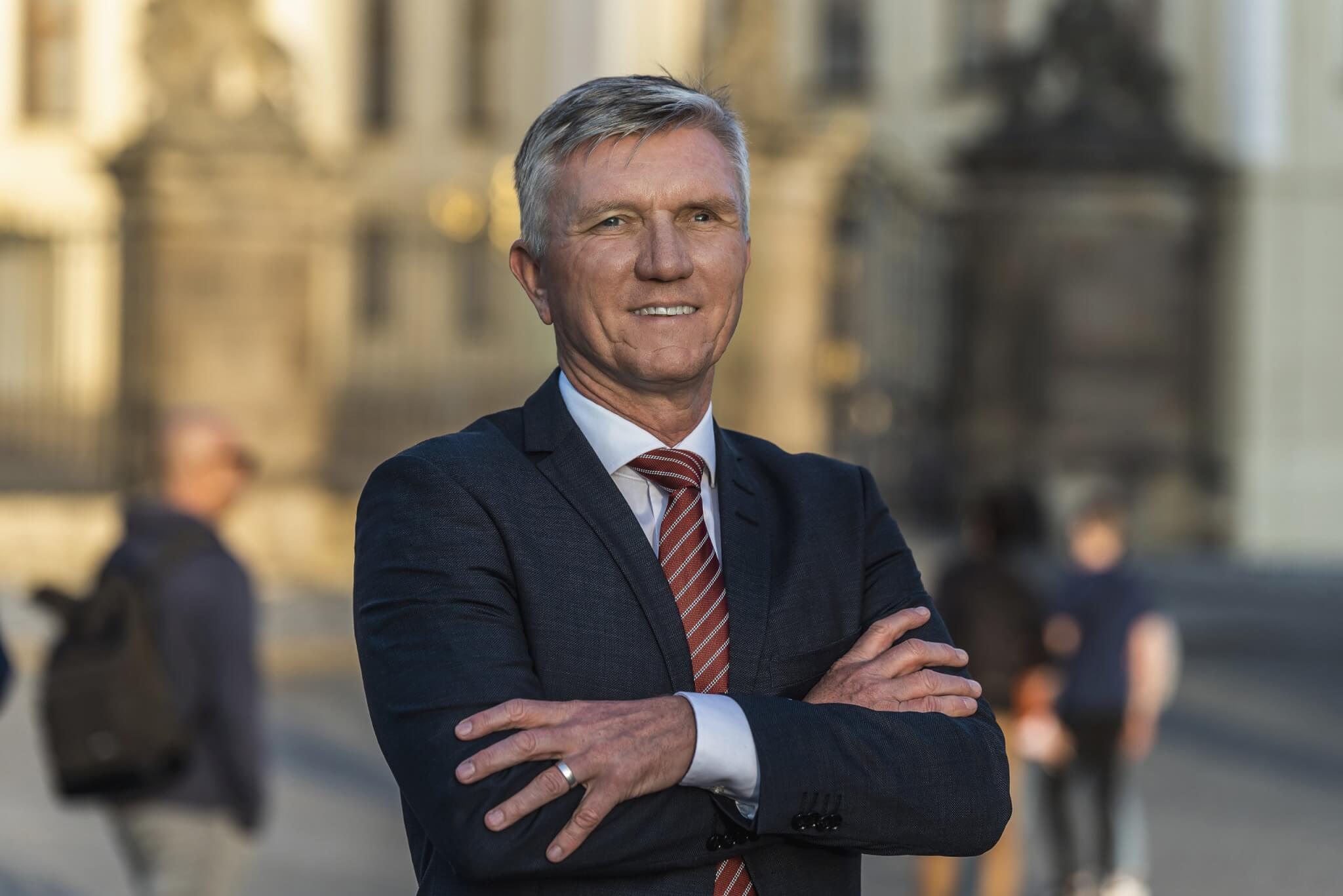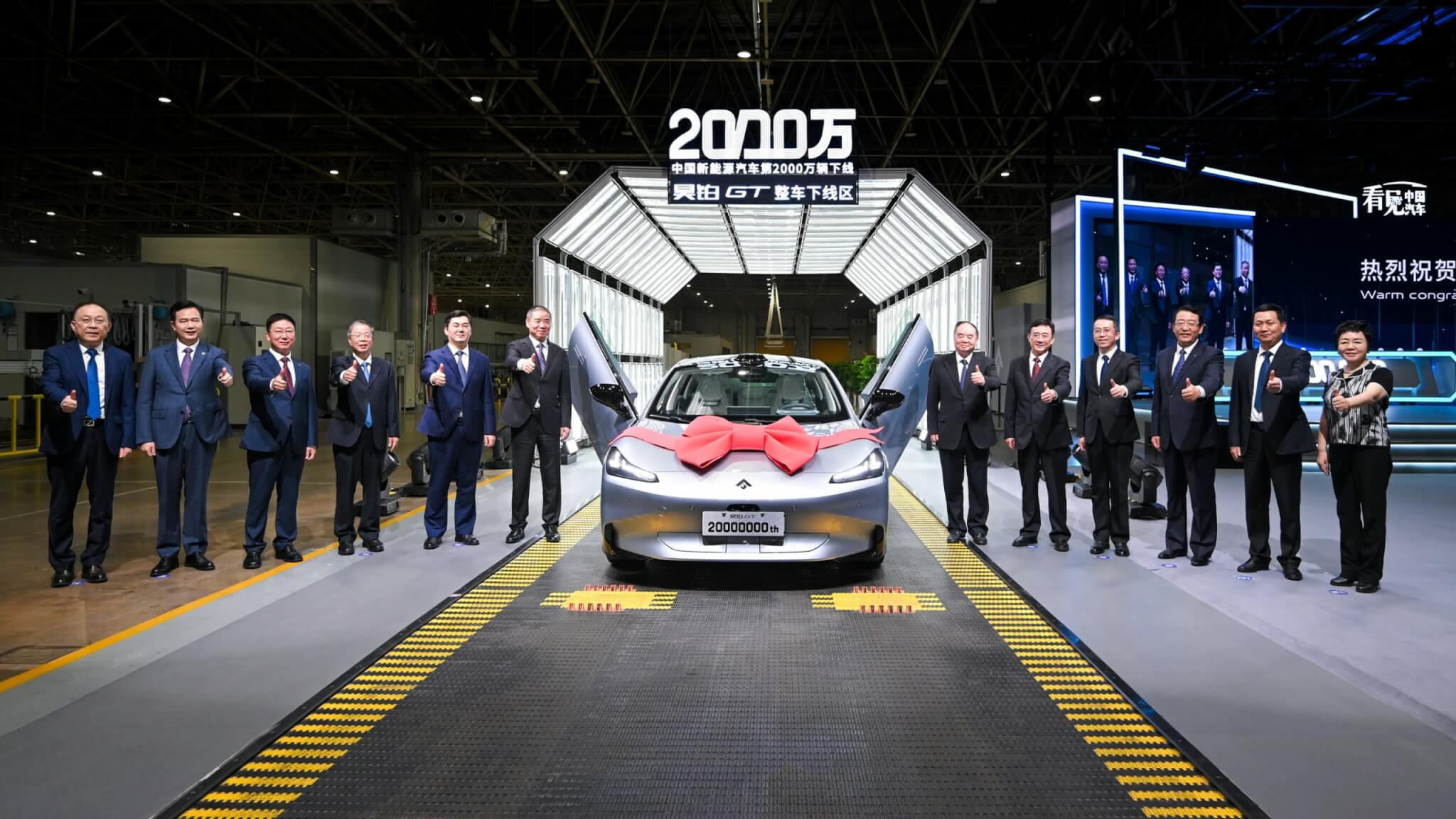The fact that someone is driving an electric car to Croatia (even for the second time) would not be worth mentioning on social media. If it weren’t for the fact that he has the opportunity to compare what it’s like to drive with a mobile phone loaded with many apps and to drive with one app that works easily and quickly all the way. The difference is really noticeable; everything is much easier with a card that is linked to an app. Which is not to say that there aren’t unpleasant surprises along the way.
We have planned a trip from Prague to Split in June/July in the Enyaq iV 80 Sportline with a claimed maximum range of 535 kilometres and for the first time this year also with the Powerpass charging app. This promises easy charging with most public providers in Europe, including access to the Ionity fast charging network, thanks to the accompanying card. There should already be over 300,000 charging stations. All charging and payment details are clearly available in the mobile app – but of course other apps offer this too.
A conventional vehicle with a tiny tank
I’m the driver, so I choose the route. I want to go via České Budějovice. The ABRP (A Better Routeplanner) app shows 1,055 kilometres to my destination and a journey time of 13 hours 15 minutes. Of that, driving is 10 hours 30 minutes, charging 2 hours 44 minutes. Five charging points are recommended. The calculator on the ŠKODA AUTO website or in the myŠKODA app shows a journey distance of 1,086 kilometres and a journey time of 10 hours 32 minutes, plus three charging stops. However, the discrepancy between the two calculations is nothing to be too bothered about – I’m going on holiday and have plenty of time.
We’re travelling in a fully loaded car, four, let’s say, fit people and adequate luggage that completely fills the boot. So I count a total of 400 kilograms of people and luggage. The good news in advance is that a heavy load on the car will have only a minimal effect on consumption. The ABRP shows only five percent more consumption with such a large load, so only minimally longer charging times.
On the eve of the trip, I recharge at Ionita Nupaka. One of the two racks is not working, the other is fortunately free. I plug in the Powerpass for the first time, insert the connector into the car, and think to myself that the world is a wonderfully simple place to live. 90% recharged. ABPR recommends charging tomorrow on the route in Linz, Trieben (Austria), Dobrenje-Maribor (Slovenia), Vukovo Gorica and Zadar (Croatia). However, as a proper Czech driver, I will still charge “at home”, i.e. in České Budějovice, which actually shows my resignation to the recommendation of smart apps. After all, why not just try to drive, plan and recharge wherever I feel like it? Just like driving a conventional vehicle with a tiny tank.

The charging infrastructure under the Ionity brand, like other operators, offers nothing but stands, but it can usually be relied on – at least because there are more stands.
Bare plain and luxury Porsche Destination Charging
It’s just kind of fitting that I stop in Trieben anyway, even though it’s not necessary, I have the luxury 46%. The local Ionity works fine. There are four stands, so we don’t have to jostle for space with the VW ID3 next to us. There’s a Spar store next door, so the 40-minute break can be used for slow shopping. Unfortunately, not for refreshments or washing hands, let alone using the toilet. There is nothing in the wide open space, which then seems very unpleasant on the way back (when the shop is closed). The asphalt is hot to the touch and there is nowhere to hide from the heat. Sure, you can sit in the car and air condition.
It’s a general problem with virtually all chargers. Unless the racks are part of the premises of a conventional gas station, the operators have built them safely in the ugliest possible place and no other infrastructure accompanies them. Summer and heat have already been mentioned, and charging in winter or rain is similarly unpleasant. So the recommendation might be: On a long journey, charge at petrol stations, although don’t expect a canopy there either. What’s more, it can be crowded at the stand.
Those who don’t feel the need to spend time at their charging car (after all, why should they, when you can check it via the app) and would like to go for a walk in the meantime, must of course also beware. Many chargers have a parking limit, and you pay an extra fee for the minutes you stand connected to the stand and no longer charging.

The Porsche Destination Charging network includes up to three thousand charging points across Europe. This one was in front of the hotel in Trakoscan.
But the embarrassing feelings from Ionita in Trieben were erased by the last stop of the day, in the village of Trakoščan, already in Croatia, in a beautiful place with a castle, where there is a Porsche charging station right at the entrance to the hotel. The Porsche Destination Charging network includes some three thousand charging points across Europe. They are at hotels, golf courses, ports and the like, simply wherever the driver is expected to spend more time. The charging points are slow, but free. So I’m plugging in, and feel free to invite the crew to dinner. That’s the way it’s supposed to be.
For the record, the total mileage for the day was 588 kilometers, it took a total of 7 hours and 30 minutes even with (sometimes unnecessary) recharging, and the average speed was 80 km/h. and an average consumption of 18.5 kWh/100 km.
Times are changing, there are few free
A morning glance at the on-board instruments looks more than encouraging: 100% charge, energy for 413 kilometres. Life is beautiful again.
I’m familiar with the Elen charging points located at INA service stations. Last year they all worked flawlessly, the recharging rate was as presented on the stand and as reported by the apps. And they were free. Powerpass can do them too, of course. It’s handy to stop in Brinje, where there’s one such charger right now, so I’ll give it a try. After a year, the situation is a bit different – at least in that they’ve been paying for the electricity they use since April. To be fair, however, it should be added that even the charged electricity at Elen is half the price of that from Ionita.

In Brinje near Elenu at the INA gas station we lingered a bit. One stand is just not enough.
There is only one rack with three ports, only one of which is 50 kW. A Kona with Hungarian plates is being recharged here, the driver announces that “in 10 minutes it will be recharged”. So we consume again and just have a snooze, preferably in the shade, it’s 35 degrees and the sky is as it should be in summer. The owner of the Kona returns after half an hour, apparently time is different in Hungary. Then it’s easy: I plug in my Powerpass card, wait (another) 40 minutes, recharge from 49% to 90%, and after two coffees, with a slight heat stroke and fried soles, I get into the car, which announces that I can now drive it for 361 kilometres without a break.

The chargers bear the logo of the European Union, which has decided to go the electric vehicle route.
It’s got to be here somewhere!
On the way, about two hours later, my co-driver is checking the app to see if he can see another charger somewhere at the right time. I want to stop, no matter what the battery thinks. To follow only the road, or rather the highway, and expect to see a sign somewhere announcing the proximity of a charger would be completely naive. One of the big problems with traveling by EV is that you basically can’t find one “just like that”. Large signs announcing in advance the existence of a conventional petrol station inform you that you will be able to fill up with LPG and air and go to the toilet there, but not if they have an EV charger.
Nowhere will you find a notice even about Ionity – and that it cost a lot of money to build it, including our own, common, European money. The chargers bear the logo of the European Union, which has set itself on the electric car path, so its infrastructure should be a showcase, the best on offer, with all the trimmings.
Yes, the charger apps usually show, but during the trip it happened that the stand was actually on the other side than announced. That is, in the opposite direction. Which is a bit of a problem on the highway.
If you’re not relying on your eyes and one app and feel the need to explore everything, you’ll also find it a bit confusing to find your way around that different apps name the charging points differently – some by rest stop, some by the nearest village/town, some by God knows what.

Navigation shows a charging station in Triebeno. But some of the charging stations are not even on the map.
The hardest part is finding a charging station in the city. The app shows many of them, but the location on the map is not 100% accurate, and the chargers are often hidden underground in garages or other spaces, with no markings on the outside.
But back to the road. We could probably make it to our destination without recharging, but why not try something else when it’s offered. Elen’s next charging point is on the highway near Skradin, unmarked, but once found… I plug in my card, charge for just a moment to make sure I don’t arrive at my destination dry, and ride the last hundred kilometers without stopping.
You want fast kilowatts?
For all the hiccups at the racks, which were neither fatal nor pleasant, the Powerpass card (like all other recharge cards from other car companies and operators) is still an extremely handy tool. With one exception, it worked flawlessly everywhere. The app will also show you what speed you can charge at which rack, but that may not end up matching reality.
With many chargers, even Ionity (Trieben, Maribor and others) the charging speed was noticeably lower than indicated on the stand. By which I don’t mean 350 kW, which my Enyaq can’t really do, but neither the dreamed 100 kW. I’ve only gotten above that limit once. Of course, there are explanations for why charging is slower than you would expect, at least that’s the rationale given by both operators and EV manufacturers: the battery is too hot, the battery is too cold, the outside temperature is too high or too low, you were driving too fast before, you drove for too short a time… But the biggest influence on the charging rate is the actual state of the battery. The charging curve clearly shows that the fuller the battery, the slower the charging. If you are charging at a rate of, say, 100 kW with a 30% charged battery, at 70% you may be charging at half that rate or even less. It depends on each individual car.
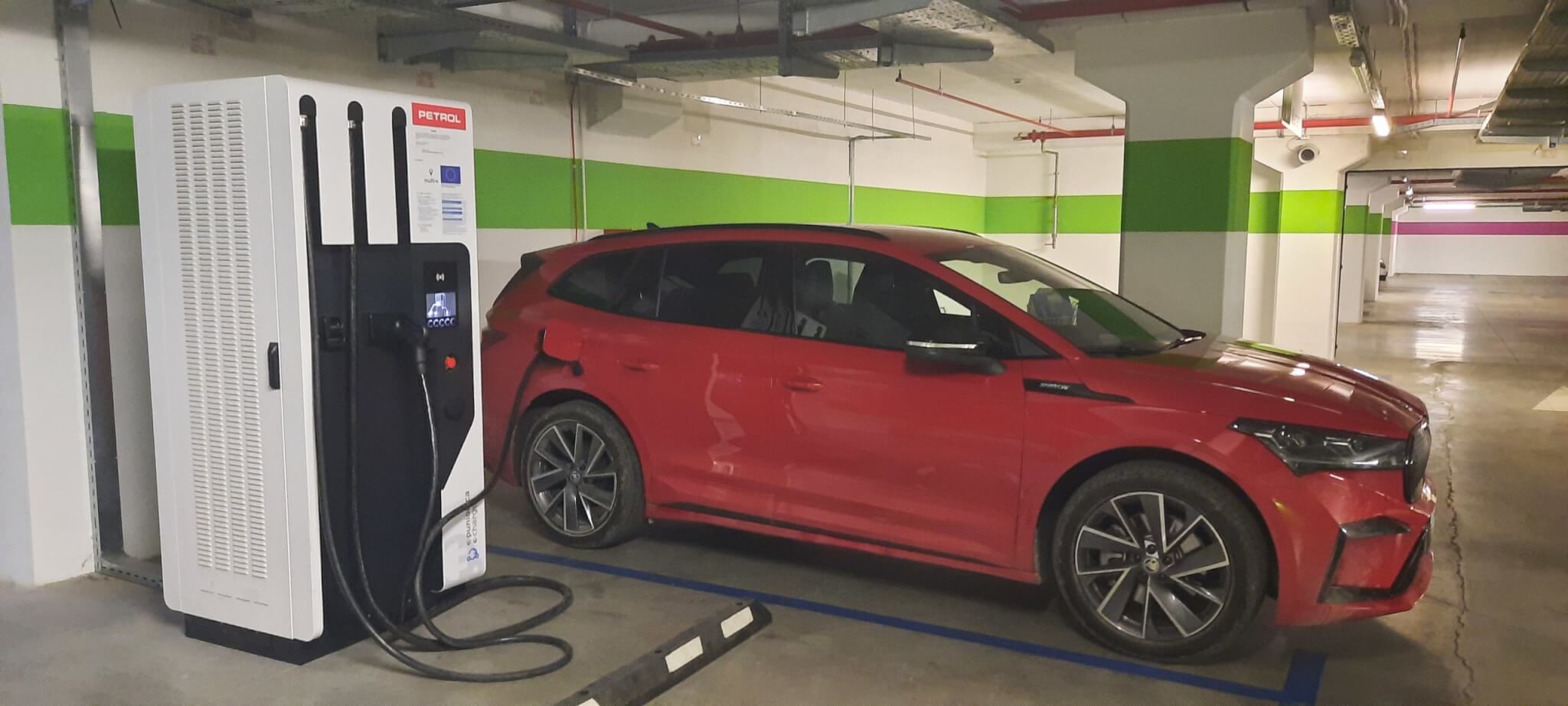
A pleasant surprise after a long search, Petrol charging station in Mall of Split.
Speaking of speed, two experiences to go with it. In Split, where even after quite a long detour I couldn’t find any of the charging stations shown on the maps (except for one, a bit strange, which didn’t work), there was a surprisingly pleasant moment in the underground Mall of Split. The Petrol charger offered only one working outlet out of three, but it was charging faster than the announced 50 kW. Ironically, it was not marked in the myŠKODA app and Powerpass did not work (although Petrols otherwise communicate with Powerpass without any problems). But when you’re a bit sloppy and leave unnecessary stuff on your phone, it can come in handy from time to time. I tried the OneCharge app for this (from last year) – it was a little more complicated, but it worked! What’s also worth adding is that there was no information at the mall’s information center regarding the charging option, and it took quite a while to find a person who explained where to eventually find it.
The way back and the clearing
Even on the way back, I didn’t follow the recommended stops, but rather my mood and what I knew from the trip there. Many things no longer surprise me. In some places it goes faster, in others it’s classic summer carnage at the gas station. In Brinja there are clouds of cars in the car park, of which there are only three electric cars – but they all want to charge. One stand is a pretty limiting affair. Fortunately, access to at least a 22 kW charging station will soon become available. It’s 2.30pm, I have 30% in the battery, and it would take (as the on-board computer says) until 7.48pm to fully charge at this rate here. On top of that, I find that the power is barely half. After 20 minutes, I park in a vacant space at 50 kW and in another half hour I have more than the necessary range to Maribor, from where I will continue to Trieben.
At the now familiar Austrian Ionita, I decide where I actually want to go, whether to Linz, Dolní Dvůr or České Budějovice. I decide for Dvořiště. And I’m doing the right thing. The E.ON charger at the local casino doesn’t have a canopy either, and if you don’t want to go throw a Black Jack, you have nothing to do here, but the 75 kW charging power has shortened the stop considerably.
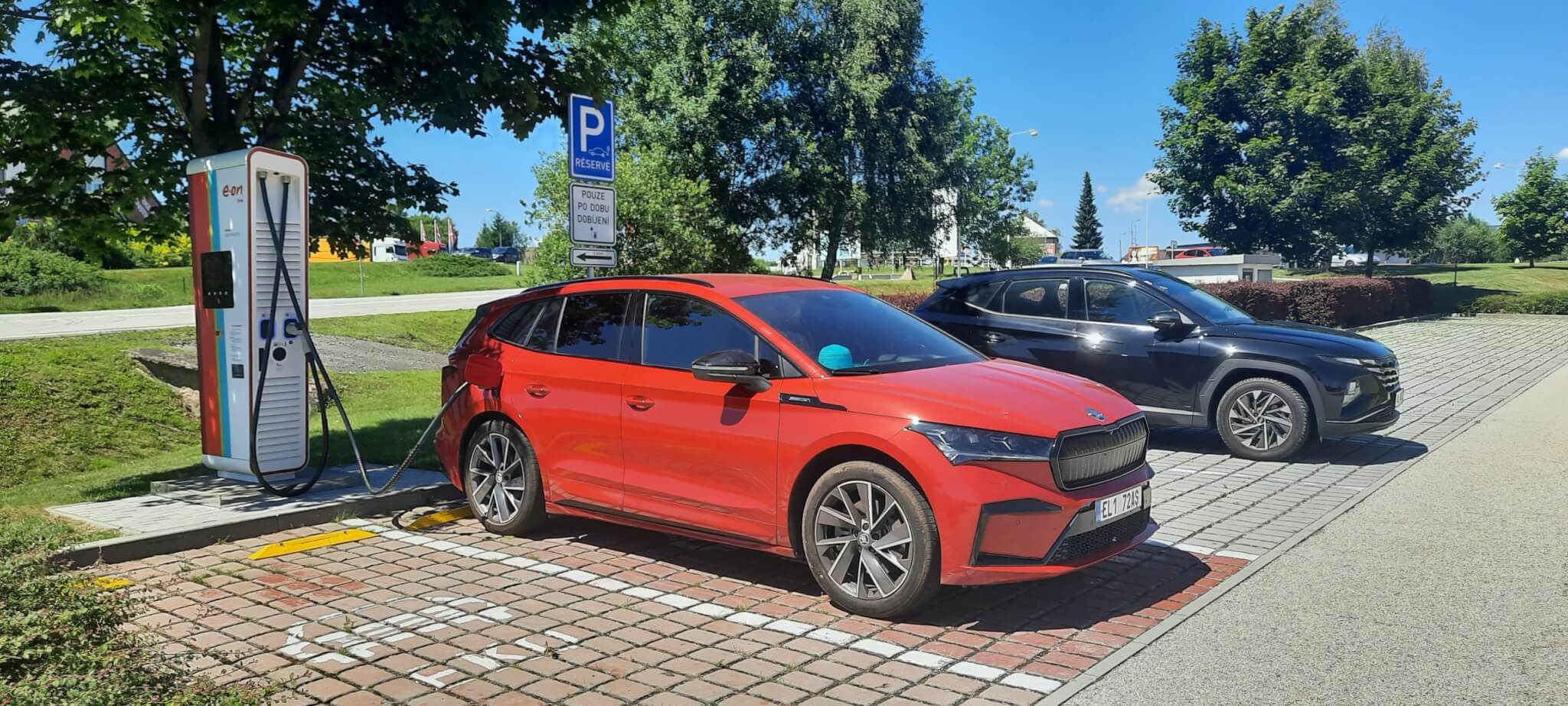
The E.ON charging station near the casino in Dolní Dvořiště was one of the fastest on the whole trip.
In conclusion, it is worth mentioning the total score: in ten days (round trip, driving around Split) I drove 2500 kilometres, consumed 484 kWh, average consumption 19.4 kWh. For electricity I paid (after recalculation) 7690 CZK, which means 15.90 CZK per kWh. Compared to the amount I would have had to pay if I had used a diesel or petrol car, it is (at the price of a litre for 45 CZK) more. But that’s only because I was paying the highest price for all the stands. Virtually everyone who drives an electric car permanently (and not just for ten days like I do) has better tariffs, which are just linked to apps and cards from either car companies or EV charging operators. The price varies, sometimes very significantly. Powerpass owners also pay a lower price if they buy one of the more convenient packages. The most significant difference is with Ionity. While one kWh cost me (Charge Free package, no monthly fee) 21 CZK, with the Charge Faster package (300 CZK per month) it is 8.20 CZK.
The prices I’m writing about here were in effect this July. However, given the erratic development in energy prices, things may be different in time. Whether the price of electricity or diesel will rise faster is hard to say.

In ten days we covered 2500 kilometres. There was no problem with the car, on the contrary, it was a very pleasant drive.
So let’s recap the whole thing
If the point of my trip (apart from the holiday) was to test whether and how a rechargeable card would make the journey easier, the conclusion is clear: A definite plus for the app and the card, it makes recharging much more convenient and actually a little faster. Now to perfect everything else. And there is still plenty of “everything else”, leaving aside the electric cars themselves (which are great – at least the ones I’ve had the chance to try), their prices, range or electricity prices.
In conclusion, I will summarize my observations here – and maybe someone will take them as recommendations on what to improve.
Compared to last year, there are definitely more charging points on the Prague-Split route, but Germany or the Netherlands are not there yet, and even there they face shortages during the holidays. More need to be built quickly and many times more stands added where they already exist. This is probably the most problematic task, because it’s not just about money, but also about enough power…

Nothing here, nothing there. But it could be worse. There’s two stands and three dumpsters.
Another major drawback is that you cannot tell from the information boards on conventional petrol stations whether there is also a charger on the premises, even on the motorway. What’s stopping you from adding a plug icon? Then I could really drive like a good old octavia. (Incidentally, I’ve just noticed these days that notices about chargers are already starting to appear in the Czech Republic, as an addition to the information board announcing the petrol station. They’re just outside the station, but at least they’re there.)
To make your trip even more pleasant, I have more recommendations. They may not be so acute anymore, but still, we live in the twenty-first century. So if a charging point or multiple charging stands are outside the urban infrastructure or even completely outside civilization, which also happens, it would be great if at least trash cans were part of that charging island. Toilets and perhaps a coffee machine or small snacks would be ideal. It’s probably a dream to ask for a shelter like the one provided by the PRE charging station in Prague 7 near the Exhibition Grounds, but maybe it will happen one day. How to get the operators to invest in it, I don’t know. All I know is that connecting a cable in the wind, rain is not pleasant.
All the more so when I eventually find out that the stand doesn’t work. Charging station operators should ensure that if the charging point is not working, this is clearly visible at a glance. It happens that the driver only discovers the fault after several unsuccessful attempts to connect the vehicle. It is clear that this information should also be available in the relevant application.
But these are probably all known things.
Contact
Next articles and interviews
Next articles and interviews
+ Show










